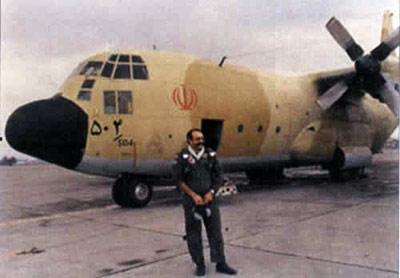Terms & Concepts
Iraqi Attacks on Civilian Airliners
Written by: Sajjad Naderipour,
Translated by: Hadi Qorbanyar
16 دورہ
During the eight years of the Iran–Iraq War, Iraqi fighter jets repeatedly attacked Iranian and non-Iranian civilian aircraft flying through Iranian airspace, in clear violation of international law.
There was no specific provision in international regulations prohibiting military attacks on civilian airliners until May 10, 1984. At the 25th Assembly of the International Civil Aviation Organization (ICAO), however, a special article was adopted,[1] stating that no state shall resort to the use of weapons against civil aircraft in flight, and in the event of interception, the lives of those on board and the safety of the aircraft must not be endangered.[2]
Despite such regulations, the Baathist regime repeatedly violated ICAO provisions by attacking civilian aircraft throughout the eight-year imposed war.
The first such case involved the aircraft carrying the Algerian Foreign Minister. On the afternoon of May 3, 1982, shortly after entering Iranian airspace, the Algerian minister’s aircraft was attacked by Iraqi fighter jets and shot down. The aircraft carrying Muhammed Benyahia, Algeria’s foreign minister, was targeted by three Iraqi fighters over West Azerbaijan Province and crashed near Kiouran, south of the Qatour region. The attack was carried out at about 5:30 PM, and all 16 people on board were killed. The Algerian minister, who was on a five-day visit to Tehran, had traveled to Baghdad two weeks earlier, and just a month before the incident, the Algerian government had announced its willingness to mediate between the two countries.[3]
Following the attack, a high-ranking 40-member delegation from the People’s Democratic Republic of Algeria, headed by then–Minister of Transport Salah Goudjil, arrived in Tehran to investigate the matter and repatriate the bodies of the victims. Twelve members of this delegation were technical experts. They were given access to all relevant documents, including telex messages, control tower tapes, meteorological data, and other records.
After the incident, commemorative ceremonies were held across Iran in honor of the martyrdom of the Algerian foreign minister. People closed their businesses in protest and denounced the Baathist regime’s attack.[4]
The next day, Iran’s Ministry of Foreign Affairs issued two statements. In the first, while expressing regret over the crash, the ministry emphasized that the aircraft had been pursued by Iraqi fighters before going down, and that evidence pointed to a premeditated conspiracy by the Baathist regime. In its second statement, the ministry stated that according to the recordings of communications between Tabriz airport control tower and the Algerian pilot, along with radar reports from Tabriz, two Iraqi fighters had pursued the Algerian delegation’s aircraft in Turkish airspace near the Iranian border. Tabriz control had instructed the aircraft to divert towards Ankara to avoid the Iraqi jets. The pilot tried to change course, at which point all communications with the aircraft were cut off. Iranian Air Force fighters immediately pursued the Iraqi jets. The audio recordings and other related evidence of Baghdad’s criminal act were handed over to the Algerian government and made public worldwide.[5]
On another occasion, at 05:51 AM on May 4, 1982, Lufthansa flight 600, a civilian airliner, was attacked near the Iran–Turkey border by the same Iraqi fighter jets that had targeted Benyahia’s aircraft. Thanks to the vigilance of the Tabriz Air Defense radar station and the swift reaction of the pilot, the plane narrowly escaped the Iraqi interceptors unharmed.[6]
On the same day, at 10:42 AM, Iraqi fighters threatened Iran Air flight 4720. The air defense officer quickly diverted the aircraft from the danger zone, provided an escort, and allowed the plane to safely enter Iranian airspace.[7]
In another case, on December 30, 1985, a Turkish aircraft carrying an economic delegation heading to Iran had to return to Turkey after being threatened by Iraqi fighter jets. The air defense radar station communicated with the pilot to warn him of the approaching Iraqi aircraft.[8]
A particularly tragic incident involving an airplane carrying fifty Iranian officials, including members of parliament, judges, and military personnel, occurred on February 20, 1986, after Operation Valfajr 8 (Al-Faw). The most prominent among the people on board was Hojatoleslam Fazlollah Mahallati, the representative of Imam Khomeini (ra) to the Islamic Revolutionary Guard Corps. While en route, their aircraft was intercepted 25 kilometers north of Ahvaz by two Iraqi MiG fighters, which ordered the plane to divert towards Basra. The pilot refused, and the MiGs attacked the plane, resulting in the martyrdom of all passengers on board.[9]
In another incident, Iraqi fighters bombed Shiraz Airport, targeting a Boeing 737 that was evacuating passengers. Five passengers were martyred and 32 were injured.[10] Following this attack, the Iranian Foreign Minister sent a letter to the United Nations Secretary-General, stating that Iraq’s attacks on civilian aircraft could lead to further crimes and requesting the dispatch of a fact-finding mission. The Civil Aviation Organization of Iran also filed a complaint with ICAO. However, the UN Secretary-General did not issue any response.[11]
In another incident, in late 1986, Iraqi aircraft pursued and threatened the plane carrying Abdulrahman Al-Ateeqi, advisor to the Emir of Kuwait, who was en route to Tehran. Thanks to the immediate deployment of Iranian interceptors guided by the Air Defense radar station, the Iraqi aircraft were forced to retreat. Al-Ateeqi’s plane, originally heading to Tehran, had to divert to the Soviet Union, where it landed safely. The aircraft had been traveling from Damascus via Turkey to deliver an invitation from the Emir of Kuwait to the Iranian President for the Islamic Summit Conference in Kuwait.[12]
Despite these criminal acts by the Baathist regime, there is no evidence in any available records of Iran attacking Iraqi or non-Iraqi civilian aircraft in retaliation. Moreover, throughout the Iran–Iraq War, international organizations remained silent on these incidents, offering no official response or position.
It appears that Iraq’s attacks on these airliners aimed to undermine Iran’s diplomatic and economic initiatives and to enhance Iraq’s strategic standing in the war.[13]
[1] Bazmi Haji-Khajehlu, Ali & Sajad Bazmi Haji-Khajehlu, Naqsh-e Amniyat-e Havanavardi dar Amniyat, Pishraft va Eqtedar (The Role of Aviation Security in Safety, Progress, and Power), Faslname-ye Danesh-e Amniyat, Sal-e 1, No. 2, 1396, p. 194.
[2] Ibid.
[3] Habibi, Abolqasem, Roozshomar-e Jang-e Iran va Araq; Ketab-e Nouzdahom: Azadsazi-ye Khorramshahr, Payan-e Royay-e Tajzie-ye Iran (1 Ordibehesht ta 31 Khordad 1361) (Chronology of the Iran–Iraq War; Book 19: Liberation of Khorramshahr, End of the Dream of Iran’s Partition, Apr 21 – Jun 21, 1982), Tehran, Markaz-e Asnad va Tahqiqat-e Defa Muqaddas, 1397, Pp. 243–244.
[4] Hamle be Havapeymahaye Mosaferbari va Havapeymarobaei, Bargi Digar az Jenayathaye Saddam (Attack on Passenger Aircraft and Hijacking: Another Saddam’s Crime), https://defapress.ir/105680
[5] Habibi, Abolqasem, Roozshomar-e Jang-e Iran va Araq; Ketab-e Nouzdahom: Azadsazi-ye Khorramshahr, Payan-e Royay-e Tajzie-ye Iran (1 Ordibehesht ta 31 Khordad 1361) (Chronology of the Iran–Iraq War; Book 19: Liberation of Khorramshahr, End of the Dream of Iran’s Partition, Apr 21 – Jun 21, 1982), Tehran, Markaz-e Asnad va Tahqiqat-e Defa Muqaddas, 1397, Pp. 258–259.
[6] Ibid., p. 259.
[7] Hamle be Havapeymahaye Mosaferbari va Havapeymarobaei, Bargi Digar az Jenayathaye Saddam (Attack on Passenger Aircraft and Hijacking: Another Crime Committed by Saddam), https://defapress.ir/105680
[8] Ansari, Mahdi & Farahani, Hamid-Reza, Roozshomar-e Jang-e Iran va Araq; Ketab-e 39, Vol. 2, Tashdid-e Talash-ha baraye Fath-e Faw (24 Azar ta 30 Dey 1364) (Chronology of the Iran–Iraq War; Book 39, Vol. 2, Intensifying Efforts to Capture Al-Faw, December 15, 1985 – January 20, 1986), Tehran, Markaz-e Asnad va Tahqiqat-e Defa Muqaddas, 1395, p. 407.
[9] Hafte-name-ye Ettelaat-e Jebhe (Ettelaat Weekly), 1366, No. 42, Pp. 1–2.
[10] Roozname-ye Keyhan (Keyhan Newspaper), Panjshanbeh 24 Mehr 1365, No. 12862, p. 18.
[11] Ibid.
[12] Hamle be Havapeymahaye Mosaferbari va Havapeymarobaei, Bargi Digar az Jenayathaye Saddam (Attack on Passenger Aircraft and Hijacking: Another Crime Committed by Saddam), https://defapress.ir/105680
[13] Alaei, Hussain, Ravad-e Jang-e Iran va Araq (The Course of the Iran–Iraq War), Vol. 1, Tehran, Entesharat Marz va Boom, 1391, p. 458.



